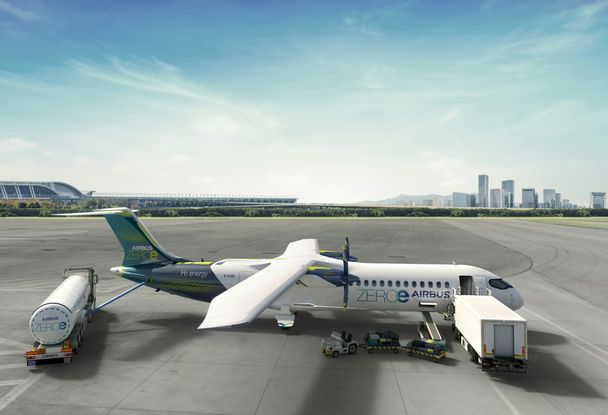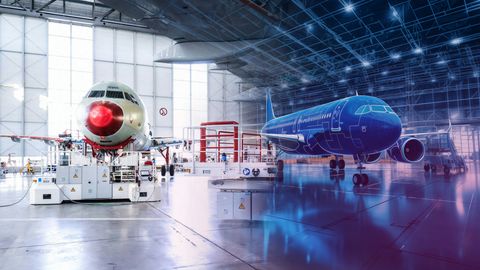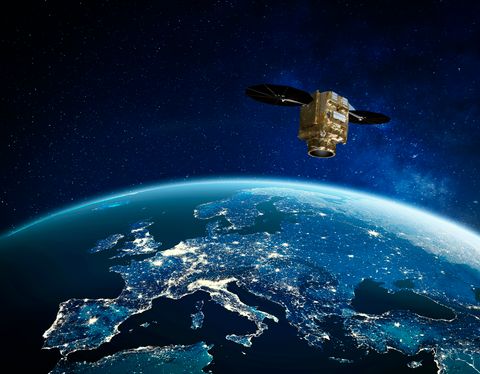Pioneering new uses for carbon capture technology

Direct Air Capture (DAC) technology was designed by Airbus and the European Space Agency to scrub carbon dioxide from the air aboard the International Space Station (ISS). After its success in space, the technology is now the focus of pioneering efforts to address climate change by using it to convert CO2 into fertilisers, fuels and carbon negative materials.
The Airbus innovation ecosystem seeks to contribute to a circular economy by identifying which internal innovations have potential applications outside of aviation. After the successful use of DAC on the ISS, as well as on submarines, Airbus Scale, our innovation acceleration unit, began investigating how the technology could be scaled and applied on land to industries that consume or produce CO2 in their production processes.
Reducing CO2 emissions is a key part of tackling climate change, especially on industrial levels. Yet despite the overabundant availability of the gas in the atmosphere, CO2 required for industrial production processes is usually manufactured through polluting combustion methods. The gas is then bottled or transported in tanks, sometimes over hundreds of kilometres, creating even more emissions.

DAC, however, presents the possibility of supplying and capturing CO2 directly onsite, cutting out suppliers and lowering both costs and carbon emissions for customers. The technology captures CO2 from the air using a solid amine-based filter, which is then heated to desorb the gas. This results in two exhaust streams: a stream of oxygenated air, and another of pure CO2. On the ISS, the oxygenated stream is vented back into the space station for the astronauts to breathe. But by venting the CO2 where it is needed or capturing it instead, a continual onsite source of CO2 recycled directly from the atmosphere can be provided.
By switching from combustion-produced CO2 to captured CO2 from DAC, farmers can become their own supplier, avoiding complicated transportation logistics, ensuring onsite availability at remote locations, and benefiting from more stable prices and a reduced carbon footprint.
New carbon capture usages
To get DAC ready for its terrestrial uses, Airbus is developing customisable hardware units of various capacities that can be configured to the exact needs of the customer. But what kind of customers are we talking about?
Agriculture
One of the industries that depends on CO2 is vertical and greenhouse farming. Although vertical farms are already an environmental improvement over traditional farming methods, lowering emissions through reduced land use, plants on all kinds of farms require CO2 as a fertiliser to boost photosynthesis. By switching from combustion-produced CO2 to captured CO2 from DAC, vertical and greenhouse farmers can become their own suppliers. This allows them to avoid complicated transportation logistics, ensure onsite availability at remote locations, and benefit from more stable prices and a reduced carbon footprint.
E-fuels production
Ramping up electrofuels (or “e-fuels”) production is an important part of the energy transition. E-fuels are produced by pulling CO2 from the atmosphere and synthesising it with hydrogen created using sustainable energy sources, such as wind or solar. When combusted in an engine, the CO2 released into the atmosphere replaces only what was previously taken out to make the fuel, making it a carbon-neutral solution. DAC therefore has exciting potential to accelerate the emergence and cost-efficient ramp-up of the power-to-liquids (PtL) processes used to make e-fuels. For example, in the aviation industry, sustainable aviation fuels can already reduce CO2 emissions by 80% throughout their life cycle. DAC can then be used to neutralise the remaining 20%, minimising emissions.
Carbon capture and storage
Another possible industrial use for DAC is using it to meet the growing demand for carbon sequestration. For industries that produce CO2 and want to prevent it from entering the atmosphere, DAC captures CO2 and separates it from other molecules in the air before converting the CO2 into liquid form. The liquid can then be safely stored underground by injecting it into saline formations.
While we are committed to reducing the environmental impact of our own products, services and operations, we also believe that we have a social responsibility to help others do the same. DAC is but one example of our ecosystem-based approach to sustainability, which supports finding new uses for aerospace technology in other industries.



